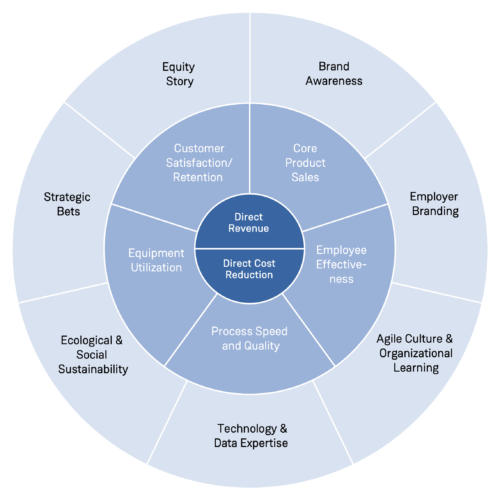
A new concept to map and design value creation from digital initiatives
Most, if not all established companies across all industries are currently busy developing digital products and services. However, questions regarding the actual value created with these endeavors become louder and the need for a “Return On Digital Investment” (RODI) becomes stronger.
While working with companies on their digital business models, we often experienced that these solutions are solely valued by their potential direct revenues or cost reductions. Nonetheless benefits often arise from the less tangible benefits that these digital solutions offer. Excubate’s Digital Value Canvas offers a simple framework to quantify both the direct and indirect value dimensions of digital solutions.
The framework was initially introduced in an article authored by Excubate founding partner Markus Anding. Now we will explore the individual dimensions in more detail and establish a structured approach for the assessment of digital products in the field. Over the course of three blog posts, we will cover the three rings of the Digital Value Canvas.
In this post we will address the Outer Ring: Goodwill & strategic impacts. To read about the Inner Ring or the Middle Ring, please have a look at our first and second post, respectively.
The Outer Ring covers goodwill-type, less quantifiable benefits
Previously, we have concerned ourselves with those benefits of digital products that can be more or less easily quantified. However, now we will address highly intangible benefits that too often remain underappreciated by senior staff mostly interested in numbers.
In many ways, companies struggling to monetize digital products directly should rather try to link them to less measurable goodwill impact. More specifically, digital products can contribute to fundamental elements of the business that define the long-term success of the company. Thus, discounting digital products due to a lack of directly measurable impacts falls short of reality and in this article, we will provide a structured approach for this issue.
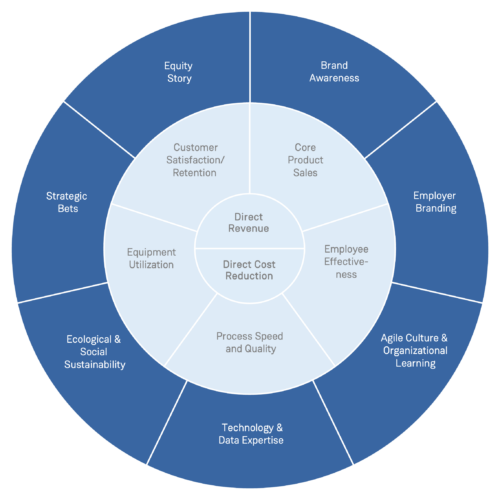
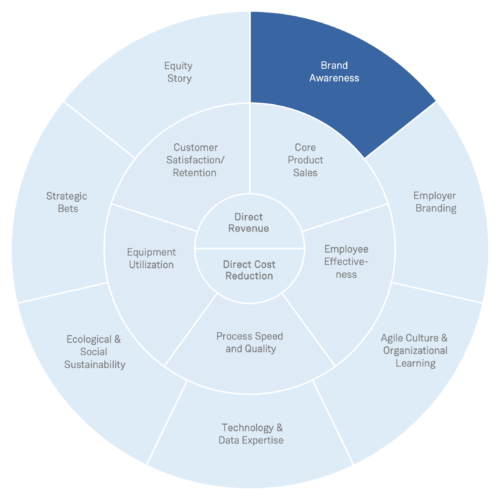
Brand Awareness
Brands are among the most valuable intangible assets
A brand is the sum of all ideas, perceptions, and emotions, which customers associate with a specific company or product. Brands distinguish a company’s products from those of their competitors. They can be one of the most valuable intangible assets in a company’s value base. Examples for well-designed and extremely valuable brands are Google, Apple or Coca Cola. Strong brands reflect a superior value promise.
Brand awareness can be defined as the extent to which a specific brand is known on consumer/customer side. This does not only include the brand name, but also familiarity with e.g. the value promise, quality, products / services, standards or history a brand stands for. An example for high brand awareness is German manufacturer ZEISS which is globally renowned for its high-quality standards, precision, and reliability.
Digital products can have major impacts on a company’s brand awareness. Two examples will give an idea on how this works:
- Pokémon Go: The Pokémon Company created its first AR based mobile game with Pokémon Go in 2016, which proved to be extremely successful. Through the introduction of the app, the company made international headlines and was on everyone’s minds. The app attracted a high number of users in a very short period of time, most of which never played a Pokémon game before. The example shows how the popularity of digital initiatives can strongly increase brand awareness. Furthermore, Nintendo (owner of the Pokémon Company) was able to use their brand’s popularity to convert a large part of the app’s new users to their console-gaming core business.
- BayDir Platform: Bayer Crop Science’s digital customer platform BayDir is a freemium smartphone app for all operating systems (i.e. iOS, Android). It is targeted at farmers, merchants, and consultants and provides services such as specific farming advice, a personalized newsfeed, and a direct contact to sales partners. The freemium sales model supported its dissemination among various user groups. The app creates daily user touchpoints, increasing the awareness for the Bayer Crop Science brand (that most customers rarely come into contact with) steadily.
Focusing Brand Awareness equals focusing on revenue increases
For the majority of products applies: the better known a product is, the more it is consequentially bought. Furthermore, customers often do not differentiate between a brand and the products sold under its name. This leads to the conclusion, that a high brand awareness can lead to a general increase in product sales in most markets.
The importance of Brand Awareness furthermore results from its influence on other dimensions of the Digital Value Canvas. The Pokémon example above showed, how brand awareness can be converted into core product sales. Moreover, companies that enjoy high Brand Awareness, often also enjoy the consumers’ trust through the sophisticated maintaining of long-term, emotionally charged relationships, thus resulting in improved Customer Retention.
However, Brand Awareness also derives some importance from the increasing importance of e-commerce. Since online customers cannot hold or feel the products they buy, they have to rely on characteristics such as average customer ratings or, trust in the brand name. More specifically, someone looking for e.g. a new phone, will usually start their research with the brand that first comes to their mind, which leads us to our next paragraph on how to measure brand awareness.
How well do your customers know you?
After the successful introduction of a digital product, the question regarding its public reaction usually comes up. Since most new products are externally focused, it is essential to monitor what customers and main opinion makers think of it. As touched upon above, this is indirectly reflected by Brand Awareness. Most commonly, it is measured by talking to a group of target customers.
In practice, customers are asked what brands come to their mind when asked to think of a certain (core) product. For example, a machine manufacturer in a B2B context could ask industry experts at a relevant trade show, while a manufacturer of toiletries with a larger focus on B2C-business could ask customers of a drug store.
The results are aggregated and divided into three categories: Top of Mind, Unaided Recall, and Aided Recall.
- Top of Mind is the first brand that a customer lists. It is often the most prominent in the media (there is no distinction between good and bad press), and it is usually considered best practice (when it is not infamous or scandal-ridden).
- Unaided Recalls are all brands that are listed after the Top of Mind brand. They are the main competitors of the Top of Mind brand and also very present in the minds of customers. Furthermore, they are substitutes and can replace the Top of Mind brand.
- Aided Recalls are brands that are not mentioned right away, and customers need to be remined of them with further assistance (i.e. a picture of the company logo) from the interviewer. Being in this category implies that customers most likely do not know the brand and thus do not include it in their buying decision.
Here, one would compare the responses of two similarly representative target groups before and after the introduction of the digital product. If it received a lot of publicity, more customers will remember its brand name without further assistance.
Nonetheless, the impacts on Brand Awareness can manifest in a multitude of ways. Other KPIs to measure Brand Awareness before and after the introduction of a digital product include but are not limited to:
- Amount of website views: The number of visitors on the company website over a specific period of time.
- Amount of search engine searches for the brand: The number of times the company has been searched for over a specific period of time.
- Frequency of brand mentions on social media: The number of times the brand is mentioned on social media outlets such as Twitter. More sophisticated algorithms can even determine the sentiment that is indirectly expressed in the social media post.
The success of most companies heavily depends on their Brand Awareness, especially in consumer goods markets, but also in B2B environments. It is therefore critical to measure the extent to which your customers are familiar with your brand.
The key to Brand Awareness
In the age of increasing customer-centricity, you should make sure that your Brand Awareness reflects your ambition. Digital initiatives can help you build up a strong and positive public perception, thereby paving the road for long-term success of your business. Can you think of a digital product that not only complements your core business but also positively furthers your Brand Awareness?
Employer Branding
In times of declining supply of top talents, companies have to reinvent their image to stay attractive. The next paragraph connects digital initiatives to an improvement in Employer Branding and gives indications on how to measure it.
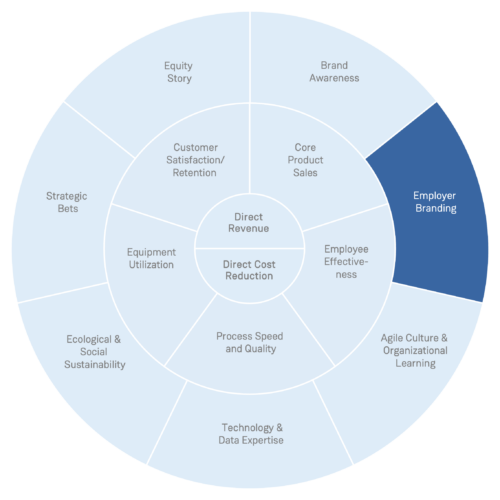
It may take a lot of effort for companies to be considered attractive
Employer Branding is closely related to the overall organization’s brand. However, it is narrower as it only considers the brand’s attractiveness from an (potential) employees’ point of view. More specifically, it is whether or not key stakeholders perceive the organization to be a “good place to work”.
Defining factors of stakeholders’ perception are for example the work-life balance that is fostered by the organization, the salary, the set of employee benefits (e.g. maternity leave) or the degree of autonomy that is promoted by superiors. Moreover, they include a company’s perceived innovation power, culture, or its success. In other word all positive feelings and perceptions that employees identify with their company, positively influence employer branding. It manifests in all initiatives that are intended to attract and/or retain the best talent for the organization and as such is a defining factor for the organization’s long-term success.
Digital solutions become more and more important in terms of employer branding. One example would be an AI-based match-making platform for internal mentoring between junior and senior staff. The automation and digitalization of mentoring improves the match-making process by connecting better-fitting individuals. This leads to a higher quality in mentor-mentee-relations which creates increased value outcome for both. As a result, the working environment improves, leading to a better perceived quality of life at work, and thus increased Employer Branding.
Strong employer brands include renowned companies such as e.g. Apple, Netflix or Google. While working there is not necessarily leading to a better life quality, their innovative products, top notch performance and, last but not least, digital mindset creates a huge attraction. It is therefore no surprise, that among the world’s most successful employer brands are mostly highly digital-focused companies.
Employees are among the top valuable assets of every company…
Therefore, it is almost indisputable that attracting and attaining top talent is a critical success factor that each company must pay close attention to. This is fueled by the “war for talents” which more and more forces companies to invest a lot of effort to attract skilled employees. This becomes more and more relevant in a digital world, with its “digital native” younger generations. AI, RPA, and cloud computing are merely a few of the digital trends that are bound to change the way we work, and in a wider sense, how organizations work.
In conclusion, although it is most likely still as important to attract and retain top talent as it was 20 years ago, it has become a lot harder. Accordingly, focus on Employer Branding is gaining more and more importance as the most critical response to the war for talent.
How can Employer Branding be measured?
The logical next question is therefore: How does one know if the initiatives that one’s company has set up actually improve its Employer Branding? Some KPIs give guidance on that matter and help to measure it.
The quantity of new job applications is a good indicator for a company’s attractiveness. Since not each application is necessarily a good one, one should only consider the amount of those candidates who were invited to follow-on-interviews. In order to measure the impact an initiative had, compare the number of new job applications over a certain timeframe before and after the introduction of a digital initiative. It should be considered, however, that the effects of digital initiatives do not develop right away, as the process of news about the initiative being disseminated among potential employees (i.e. everyone who is currently not working at your company) takes some time. Therefore, it is advisable to compare the month before the introduction to e.g. the fourth month afterwards. An example for such a digital initiative is the acceptance of digital job applications via platforms like e.g. LinkedIn. Especially digital natives are used to fast and digital forms of application and will often shy away from classical, lengthy processes.
The quantity of applications neglects already hired employees. To measure their satisfaction, the turnover rate is a well-known KPI. It indicates how many employees left the company and had to be replaced. In larger companies these numbers can be output from the internal HR system. Here again it is recommended to wait a certain period before comparing turnover rates bevor and after the initial implementation of a digital initiative that might improve it. An example for such could be solutions that improve the employees daily work life, e.g. by automating travel expenses, enabling canteen food preordering, the digitization of meeting room reservations, an internal employee carpool app or something simple as the introduction of Slack.
Next, as above mentioned, one could also consult employer rating platforms such as Glassdoor.com. On these platforms employees, disgruntled or happy, can rate your organization and thus express the general feelings towards it. If a digital initiative had a (positive or negative) impact on your Employer Branding, you will receive first-hand feedback through these platforms. As opposed to the turnover rate, you will receive this feedback quite immediately as employees are usually most emotional about an initiative right after its introduction. This makes employer ratings the ideal KPI to test the short-term impacts of your digital initiative.
Call to action
Are you aware of how former and current employees perceive your company? Check out now if your company has online ratings, engage an employee you have not talked with in a long time and think about what you can do to actively improve your employees work life!
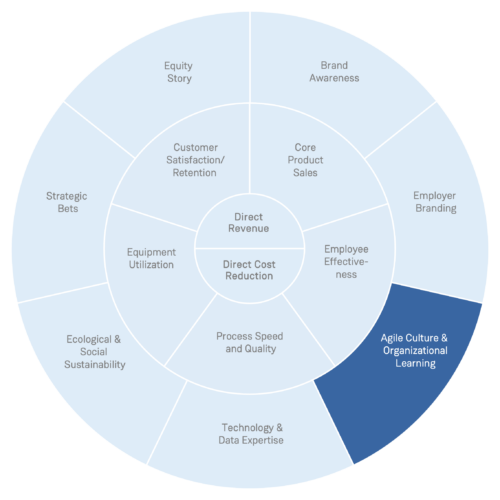
Agile Culture & Organizational Learning
In today’s fast-moving world it is important for organizations to adapt to new circumstances in the timeliest manner possible. Failing to do so will result in the falling behind of the organization and in the long-term to financial problems. In the next paragraphs we will highlight in what ways digital products can help an organization to grow with new technological challenges and develop a future-proof culture that contributes to continuous organizational learning.
From software development to business project management: What is agile?
An organization with an agile culture manages projects by applying agile software development methods, Scrum and Kanban being the most prominent ones. Although originating from the fields of software development and IT, agile methodologies have become an almost universal theme in modern organizations. They are usually characterized by four main components:
- Iterations and incremental steps
- Efficient face-to-face communication in cross-functional teams
- Short feedback loops enabling continuous improvements
- A strong focus on quality and the customer/user
The flexibility of these approaches allows for quickly successive release cycles, something which is becoming more and more important even outside the domain of software development. Furthermore, the customer-centricity ensures that only what is really needed/desired by the end-user is actually realized.
Together, these factors make agile methods fundamental, almost to the degree of raw necessity, for the development of digital products. As a result, the development of digital products often goes hand in hand with improvements in Agile Culture & Organizational Learning.
It is to be noted, however, that having an Agile Culture does not mean to strictly work in cross-functional teams and follow some method religiously. Instead, the process of project management should be re-evaluated constantly to make sure that the right people are involved at the right time and the touch to (business) reality is not falling short.
A good example for the manner in which digital products impact Agile Culture & Organizational Learning is the intelligent Report Service App by the KION Group AG. In a dedicated setting called the “KION Digital Campus”, which is solely reserved for the development of digital products, cross-functional teams work together using a value-based validation process.
In this setup, agile approaches are applied by changing BU/customer experts, thereby carrying the techniques and agile mentality out into the organization. As a welcomed side-effect, by working in this mode the different functions within the firm are exposed to new technologies, thus allowing them to develop new capabilities and expertise areas.
Why adopt agile methods instead of traditional ones?
As people are getting used to the experiences they make in their private life (e.g. next day delivery on Amazon.com), more and more experiences that were traditionally exclusively available to B2C business are being demanded in a B2B context. This forces companies to focus more heavily on the customers’ point of view in order to keep up with competition. However, this also opens up various opportunities:
By getting to know their customers in a more intimate way, companies can predict certain behaviors, create more attractive products, and improve their marketing. The development of digital products offers companies a testing field to experiment with agile methods and new ways of project management. These capabilities may not influence today’s core business in a tangible way but will determine a company’s future development in success-critical ways.
In the era of next-day-delivery, daily innovation, ephemeral trends, and disloyal customers, companies also need to embrace change in order to master the volatility of their markets. Customers demand timely and flawless solutions. While agile development helps to identify and deliver on these new demands (e.g. short release cycles, daily touchpoints, strong engagement), it also needs a clear mandate within the organization to circulate and be established. The best way to introduce an organization to it, is by implementing successful lighthouse projects.
The development of digital products has proven to be a great way to enable the aforementioned. A good example is German machine manufacturer Trumpf which started its digital transformation among other things with the execution of campus-mode projects. These agile-driven lighthouse projects found a lot of approval within the organization and information about them spread fast throughout the company. Today, Trumpf executes many of its projects in campus-mode and has already built a track record of successful agile projects throughout the whole organization.
How a lighthouse project can improve Agile Culture & Organizational Learning
The effects the development and subsequent introduction of digital products can have on a company’s Agile Culture & Organizational Learning may sometimes be rather hard to grasp. After all, this value lever is located on the Outer Ring of the Digital Value Canvas. As the above example illustrates, however, the introduction of a first lighthouse project which adopts agile methods for its project management, can have large-scale effects.
A comparatively straight-forward way of measuring this impact is estimating how many non-project employees were informed in one way or another about the project and, more specifically, its agile methodology. This can manifest in a number of ways, some of which are
- a company-wide newsletter
- a public announcement during a shareholder meeting
- coverage by an external media outlet
- word of mouth between project and non-project employees
- upwards feedback by the project team
As the word gets out about the flexibility and efficiency of agile approaches, general interest peaks and more projects will be implemented in an agile manner. For this, of course, more employees will have to be formally introduced to the methods and levers of agile methods, thus creating a new area of expertise for them and resulting in the overall organization’s learning. Practice has proven that this knowledge spillover effect has the potential to alter the way organizations operate entirely, thereby making them more flexible as well and adaptive to external challenges.
Start today, by asking the right questions!
Agile methods start with agile people! Commit yourself to asking these three questions once a day in a meeting for one week:
- What does this mean for our customer?
- How can we generate value from this?
- Which internal expert or customer can give us feedback on this matter?
Technology & Data Expertise
In the last part of our series we covered Agile Culture & Organizational Learning as a distinct value driver for an organization. However, the segment focused heavily on concepts and methods that could be learned by and trained to employees. Now, we would like to shift the focus towards knowledge, or more specifically technology and data related. The next paragraphs will elaborate how digital products can foster and enable a higher degree of Technology & Data Expertise.
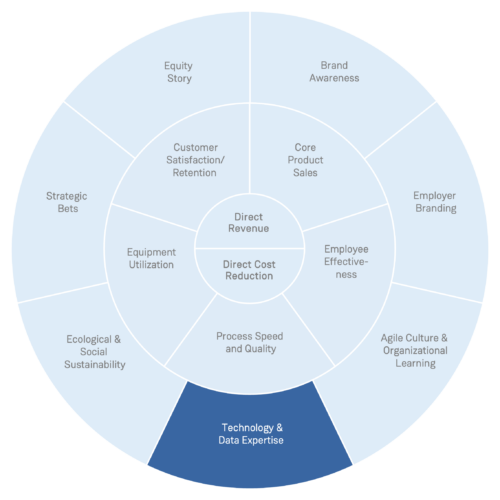
How digital products and technological/data expertise are related
Data is a collection of qualitative and/or quantitative variables and has evolved to be one of the most influential and decisive resources. From large amounts of data information (i.e. useful conclusions from data) or trends (i.e. tendencies in the data) can be derived. These derived information packages form the basis for management decisions.
Technologies are techniques and skills involved in the production of goods or the provision of services. This makes technologies essential for the delivery of the core business. Today’s digitally affine business environment enforces both new technologies and large amounts of data on organizations of all sizes and especially the development of digital products touches upon both.
A great example for a company that sustains their employees’ technology expertise is a German machine manufacturer.
To sustain and improve employee technology expertise within organizations, different approaches can be adopted. An example is a global acting German glass producer: For the purpose of training and knowledge transferring they initiated an internal TV show that is broadcast online. In this show employees are interviewed about a variety of technology topics that they have substantial knowledge of as a result of their day to day tasks (e.g. IoT, AR). Over 5,000 employees follow these interviews on a regular basis and thus learn about the company’s technological resources and innovative projects.
Another way in which digital products can improve an organization’s Technology & Data Expertise is through the development process. In our previous chapter we focused on the methodological aspects of a (software) project, however, the development of digital products bears a lot of chances for the building of internal know-how, e.g. communication tools, through for example the interaction with IT-relevant personnel e.g. architects, developers. Furthermore, modern projects are oftentimes implemented with teams located around the world so the knowledge of and proficiency of remote working tools, e.g. Miro, is enhanced.
Especially challenging times require Technology & Data Expertise
According to research, global data creation will reach 2,142 zettabytes (1 zettabyte are 1,000 terabytes) (Source: Statista Digital Economy Compass 2019). If used effectively, this incomprehensible amount of data is an almost endless source of value, but the true (economic) value of data has yet to be understood on every corporate level. Only then, this critical asset is handled in the most value-adding way. Many organizations merely collect data but fail to generate value from it through the derivation of meaningful information.
Furthermore, both technology and data are close to the core business due to the digital nature of today’s economy and technology’s necessity for the provision of core products. Therefore, enhancing Technology & Data Expertise through digital products prepares the core business for future challenges.
One major challenge the world faces at the moment is the coronavirus which has disrupted almost every aspect of business. Many organizations have sent their employees home, which results in dissonance, not only between levels of hierarchy but also teams.
To ensure a smooth resumption of all projects, technology tools can be used for project management tasks. Video conferencing, online communication channels, (cloud-based) file sharing services and a wide variety of other solutions enable effective project collaboration. All that is needed is the right expertise and experience to guide through the remote work and use the right tools for the right purpose.
How to approximate Technology & Data Expertise
Similar to Agile Culture & Organizational Learning, it is also rather difficult to quantify Technology & Data Expertise. A good approximation is again the number of people that are reached through an initiative. In the provided example above, over a third of all employees were reached through the digital service (i.e. the internal TV show), thereby furthering their understanding of the technology used in the company. For the exact quantification of this metric, technology can help: Software tools offer detailed insights regarding the content engagement e.g. the click-through-rate, or the number of impressions.
Are you reaching your full potential?
Ask yourself what kind of data you are generating and collecting each day. To validate whether you are actually getting the most out of it, think of three insights that you have derived from your data in the past week. If you find this difficult, you should think about what technology you could adopt to help you.
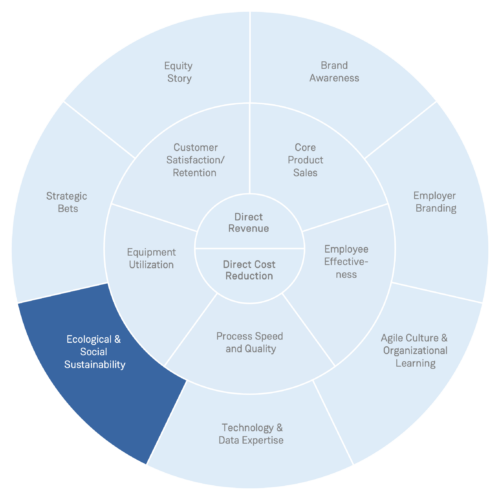
Ecological & Social Sustainability
The recent COVID-19 pandemic has shifted our focus towards the people surrounding us and how our actions influence them. Many western businesses have undergone a similar shift in recent years, more specifically one towards Ecological & Social Sustainability. This shift is also about paying more attention to the consequences that one’s actions have on others.
A variety of studies have shown that sustainability considerations directly impact financial performance. Consequently, increasing an organization’s Ecological & Social Sustainability enhances long-term profitability and, in this section, we will address how digital products can achieve this goal.
Sustainability is the trinity of ecological, social, and economic sustainability.
Ecological sustainability consists of stability, which is an ecosystem’s capability to return to its original state after a disturbance, and resilience, which is an ecosystem’s capability to return to ANY functional state after a disturbance. To sum it up, ecological sustainability is the preservation of an ecosystem’s biodiversity.
An example for a digital solution that improves ecological sustainability is AR remote assistance for B2B machine manufacturers. Through AR equipment, a service employee is able to guide a customer through the maintenance or simple repair of a machine without having to leave his desk. As a result, all ecological cost associated with travelling are set to zero and CO2 emissions, as well as the need for fuel are diminished.
Social sustainability has two components: The internal one is the management and maintenance of cultural diversity, gender equality and healthy practices for employees in general. In essence, the internal perspective is similar to Employer Branding as it, too, aims at creating and cultivating a “good place to work”. Furthermore, social sustainability has an external component. It is concerned with ensuring e.g. that exploitation of human or natural resources is prevented, or that no trade is conducted with dictators.
Again, digital products can have a lasting impact on a company’s social sustainability. The COVID-19 pandemic forced companies to send their employees to the home office in order to slow down the spread of the infectious virus. Simultaneously, citizens were urged to limit all social contacts to the bare minimum. As a result, feelings of isolation and disconnection set in for many employees.
To address the issues related to working from the home office, companies quickly moved to digital solutions such as videoconferencing or collaborative online tools that would allow employees to continue interacting and cooperating with each other almost as if they were located in the same room. For example, videoconferencing tools allow the transmission of body signals and language that would otherwise get lost via the phone or emails and thus create deeper, more personal communication. As a result, employees feel more included, less alone, and more comfortable in their team.
An example that shows how a company’s actions can also have a large effect on external social sustainability is American jewellery house Tiffany & Co. started the Diamond Source Initiative project, which would allow them to trace and identify all of their diamonds via blockchain technology. This has a lasting impact on the trade of so called “blood diamonds”, or unethically sourced diamonds.
Although not expressively addressed by the Digital Value Canvas, for the purpose of completeness we shall also briefly elaborate on economic sustainability. In this context, it is the practice of ensuring long-term economic growth, while simultaneously minimizing the impact of said growth on social or environmental sustainability. Essentially, it is a matter of resource efficiency, i.e. utilizing the available resources in a way that maximizes the achieved output while preventing the overexploitation of finite resources at the same time.
A good example here would be Microsoft’s Azure for the energy industry. With an arsenal of technologies such as digital twin, AI, and cloud computing, Azure transformed the energy sector to increase its economic sustainability. In Norway, for example, Azure and Hafslund Nett (Hafslund), a major power grid operator, developed the basis for a nation-wide rollout of smart metering, which effectively provides real-time information about the country’s power consumption, which in turn allows Hafslund Nett to produce only the energy that is needed.
How sustainable practices ensure long-term success
Today, more goods are produced than ever before and the production, distribution, usage, and disposal all take a heavy toll on the environment.
However gloomy this may sound; it did nudge societies around the world to act more responsibly. Nowadays, Ecological & Social Sustainability are not just buzzwords to attract media attention, but for most companies they have become an ethical and financial imperative in order to sustain profitability in the long run.
In practice, it means that for example rare resources, such as most required for the production of mobile phones and other advanced electronics, need to be recycled and reused as their supply is either very limited or hard to source (i.e. because resource occurrences in nature are not very rich).
As for social sustainability, academic research and practical experience has shown that diverse teams outperform those that are not on all dimensions. Often the most innovative ideas come from groups with many minds that are not exactly alike, either due to their cultural background, age, sexuality, gender, or other circumstances. Therefore, in order to ensure that there will be any business to be made in the future, one needs to pay close attention to Ecological & Social Sustainability.
Capturing the effects of sustainable practices
Measuring the impact that digital solutions have on Ecological & Social Sustainability is challenging but these guidelines for the quantification of the impacts resulting from sustainable practices provide an initial overview. First, one can consider the amount of CO2 emissions that are caused by the operation of the company. As highlighted in the above example, digital solutions have the potential to reduce the need to travel, and as a result reduce the amount of CO2 that is emitted.
Additionally, it is noteworthy that many countries already discuss CO2 taxes and fees for those that emit the notorious greenhouse gas in large amounts, thus in the near future, reducing emissions will also become an important cost driver. Furthermore, one could evaluate the company’s gender pay gap- a metric that mostly comes to play in the social sustainability context. Ideally, a company would exhibit a gap of zero, but in reality, this is seldom the case.
Another insightful KPI is the number of employee sick leave days per time period. The number of sick leave days can be used to draw conclusions regarding the organization’s overall employee satisfaction, more specifically if the organization facilitates a “good place to work”. On these grounds it is a suitable measure to gauge a company’s social sustainability.
Lastly, KPIs such as a company’s Corporate Social Responsibility (CSR) score can provide insights on how responsible a company is operating. Although both debated and criticized by many, research has shown that there is a significant positive relationship between a company’ CSR score and its financial performance (Mohr & Webb, 2005).
Time for change
Take some time to reflect the impact your company has in social and ecological terms. What changes in policies or what digital products could make a great change?
Strategic Bets
Preparing for what might happen in the future is what is generally understood by the notion of “strategy”. Following this line of thought, Strategic Bets are the opportunity to benefit commercially from a digital product or capability in the future. The following paragraphs we will highlight the strategic relevance of Strategic Bets for an organization’s future success.
Strategic bets: high ambiguity, even higher reward
Strategic Bets are bold strategic decisions that have the potential to transform the underlying organization and the industry it operates in significantly. Digital solutions that fall into the category of Strategic Bets adopt nouvelle technologies or business models that have as such not been employed within the organization before. Often the core business is disrupted in the medium to long-term, in which case the growth trajectory of the organization changes inevitably and with it the organization’s staff and processes. The former facilitates the new skills required for the adoption and implementation of the new technology, while the latter enables the smooth operation of the digital solution.
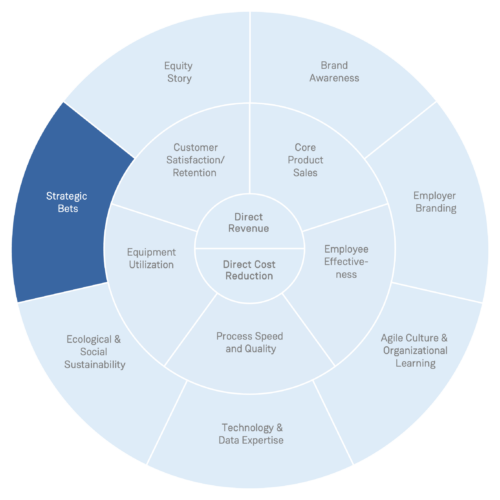
One examples of a digital product that fit this description is the development of an online sales portal for a product that traditionally relied heavily on face-to-face interaction between the customer and sales personnel, as well as personal consulting (e.g. private health insurance). Another example would be the introduction of a digital alternative to the main offering of the core business, which, if successful, inevitably leads to the cannibalization of the core business (e.g. Netflix back in 2007).
To clarify the difference between a Strategic Bet and a regular strategic project, we will outline three factors we deem decisive for the proper categorization of projects.
- Large value potential. What makes Strategic Bets attractive, is their potentially great payoff in the long-term. Adopting a previously industry-unrelated technology to develop a new digital product can prove unsuccessful in the end but being the first mover provides a range of competitive advantages. These materialize in the form of e.g. a high market share, less susceptibility to external disruptions, or the tapping of a new market.
- High degree of ambiguity. As the name already suggests, Strategic Bets inhibit an exceptionally high degree of ambiguity. Here, one must consciously differentiate between risk and ambiguity. While risk is characterized by known probabilities (the chances of winning the lottery are roughly 1 in 14 million), for ambiguity not even all possible options are known. An example would be a lottery without a previously defined range of numbers that can be picked, meaning it could be either only one to five, or one to 5,000. The same applies to Strategic Bets. There is no way of knowing if the investment will be worth it in the future.
- Long timeframe. The longer into the future one intends to predict possible outcomes of a situation, the harder it is to make justifiable predictions. Therefore, a decisive characteristic of Strategic Bets is their long timeframe they impact. An imminent by-product of this is the ambiguity described above.
Two examples will illustrate this understanding:
Adobe Creative Suite: From perpetual license to Creative Cloud
In 2013 Adobe replaced its highly successful Creative Suite product (market leader in image editing, photography, and graphic design software) with its cloud-based product Creative Cloud. Instead of releasing new versions of the Creative Suite and selling them for large one-off license prices, Adobe changed the business model to SaaS. This was a bold move in 2013 and the risk of changing a successful product so drastically was high. In the end, the bet paid off, making Adobe a successful early adopter of cloud products and SaaS, allowing the company to further reinforce its market leadership.
Heidelberger Druck – Printing as a Service
German printer manufacturer Heidelberger Druck drastically transformed its core business from hardware sales to an end-to-end printing as a service solution. The initial aim was to enlarge the market power by vertically and horizontally integrating at once and simultaneously strongly digitalizing the core business. This Strategic Bet backfired, leaving the German company struggling with severe cashflow problems.
A business decision of life and death
Strategic bets can strongly influence the overall chances of survival of companies. A move that seems bold today can be critically necessary in the future. An often-quoted example is Kodak’s decision in the early 2000s to not focus on its initially created digital camera. The fear of cannibalizing its core business kept Kodak from entering the digital photography market. As a result, the company went bankrupt over the course of three years due to rapidly changing, unanswered customer demands.
Strategic bets offer a chance to acquire control or even create a monopoly on critical resources, markets, or competencies. In shifting industries like the photography market mentioned above, companies that bet on change are rewarded- by remaining competitive. Strategic Bets offer companies the opportunity to practice a form of large-scale entrepreneurship, a competency that gained more and more relevance over the last years.
Most markets today are strongly shaped by uncertainty, ambiguity, and volatility. This phenomenon leaves market players with no choice but to courageously invest in strategic bets to stay competitive. Since many markets currently transform from analogue to digital, especially digital initiatives are often the basis for such bets.
How can you measure it?
The ambiguous nature Strategic Bets makes their value incredibly hard to estimate and so far, there is no established approach. Therefore, the subsequent method is merely our educated perspective on the matter. More specifically, we would like to propose a measure we label Strategic Value Potential (SVP). It is a fraction that consists of two components: The estimated value pool and the cost associated with the failure of the project. For example, if the total addressable market of a digital solution is estimated to be $100 million in 10 years, and 10% of this market can realistically be attained, the value pool would be equal to $10 million.
However, the associated costs are estimated to reach $8 million (including all costs associated with the development, the market launch, and other related cost). As we divide the value pool by the cost of failure, we arrive at a ratio of 1.25. Naturally, one would have to define how big the ratio would have to be in the context of the situation for the project to be considered a success. While this this measure is indubitably only an approximation, it does provide insights into the upsides and downsides of Strategic Bets.
What change are you betting on?
Conducting successful business today always means balancing exploitation and exploration. Even though your core business might currently be successful, what digital initiatives are you betting and investing on, to keep it prospering in the future?
Can you think of theoretical scenarios that will strongly influence your market? What can you do today, to set the path for reacting successfully on a variety of unpredictable changes tomorrow?
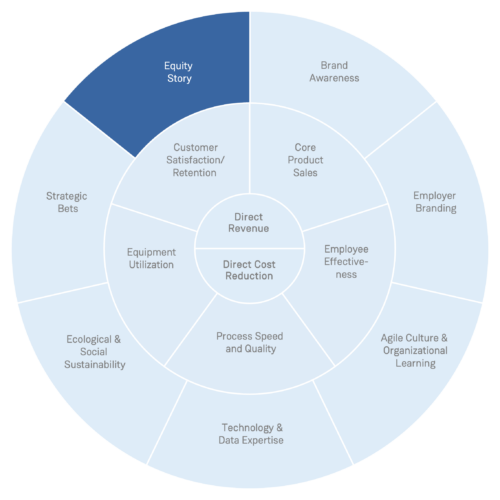
Equity Story
Last but not least, we will address the value driver Equity Story. Equity Story is a line of reasoning describing why investors should be interested in buying shares of a specific company. Building and delivering a convincing Equity Story is fundamental for raising capital in the market and in many cases digital initiatives played a substantial role in the development of a compelling Equity Story. In the following paragraphs we will highlight the relationship between digital solutions and an Equity Story, and we will elaborate how the relationship can be translated into financial parameters.
The basis of investments
As touched upon above, a company’s Equity Story is the collection of arguments of a company that is to persuade investors to invest in the company’s shares. In essence, it reflects a company’s value potential, market potential, success drivers, strategy, culture, and stability. These are communicated in the form of financial publications, press releases, the company website, or media outlets. Combined, they add up to Equity Story which is consequentially an indicator of a company’s attractiveness to potential investors.
This attractiveness is decisive for an organization’s success; no matter how mature it may be. Securing funding is as important during the early startup phase as it is during later, more established phases. In the former, a compelling Equity Story helps to attract investors which will allow the company to initiate the process of scaling. In the later, the Equity Story helps to shed some light on the inner workings of the complex organization and its values in order to retain existing investors and win new ones.
A suitable example of a digital solution that has a positive impact on a company’s Equity Story is IBM’s adoption of blockchain technology in 2017. Their “Blockchain as a Service” model had a positive impact on their already strong public presence through a number of newspaper articles and blog comments. Furthermore, by embracing blockchain technology, arguably one of the most disruptive and innovative technologies in the past decade, IBM displayed a strong determination to future-proof its product portfolio.
As another example, consider a sizable accounting firm that is publicly traded and mostly services local clients. If it were to announce the implementation of a new AI-based system to automatically identify tax benefits, it would indubitably impact multiple dimensions of the Digital Value Canvas, but it would also positively influence the firm’s Equity Story. This move towards a more digital and efficient operation improves future competitiveness and thus makes the firm more attractive to potential investors.
External capital for the scaling of operations
Equity Story is one of the most important levers for financial sustainability as it allows firms to attract investors and scale its operations beyond what would be possible without external funding. However, a good Equity Story is not only relevant for potential new investors but also for those that are already invested. It is also in their interest to create a good Equity Story as this will inevitably maximize their own shares’ value.
Thus, Equity Story is a lever that is both internally and externally focused. Furthermore, it is relevant on two different time horizons; First, and most understandably, it is relevant for the current company performance by enabling the raising of capital for the purpose of scaling operations. Second, it sends important signals regarding the future readiness of a company. If, for example, a breakthrough technology is adopted, investors will see this as a positive indication for the company’s future success and thus invest in it in the present.
In the end, most digital solutions also impact a company’s Equity Story as they are positive indications for a company’s ability to adapt to the advancing digitalization and new market trends and technologies.
Increase the market valuation
Although being located on the Outer Ring of the Digital Value Canvas and therefore particularly intangible, measuring the impact an Equity Story can have on a company’s performance is relatively straightforward. More specifically, a direct KPI is the market price per share. It reflects the fraction of total market value that can be assigned to one share, and thus quite directly reflects the positive impact a company’s Equity Story has on its valuations.
Furthermore, digital solutions have the potential to improve a company’s value generation process and increase profits. An increase in profitability positively influences the Equity Story and the value of the company. The increase of value generation through a digital solution can therefore serve as an additional KPI.
Pitch your story!
Most digital initiatives have the potential to increase your firm’s Equity Story. If you were to pitch it for your investors today, what would be your three main selling points and how is it generating value for your stakeholders?



